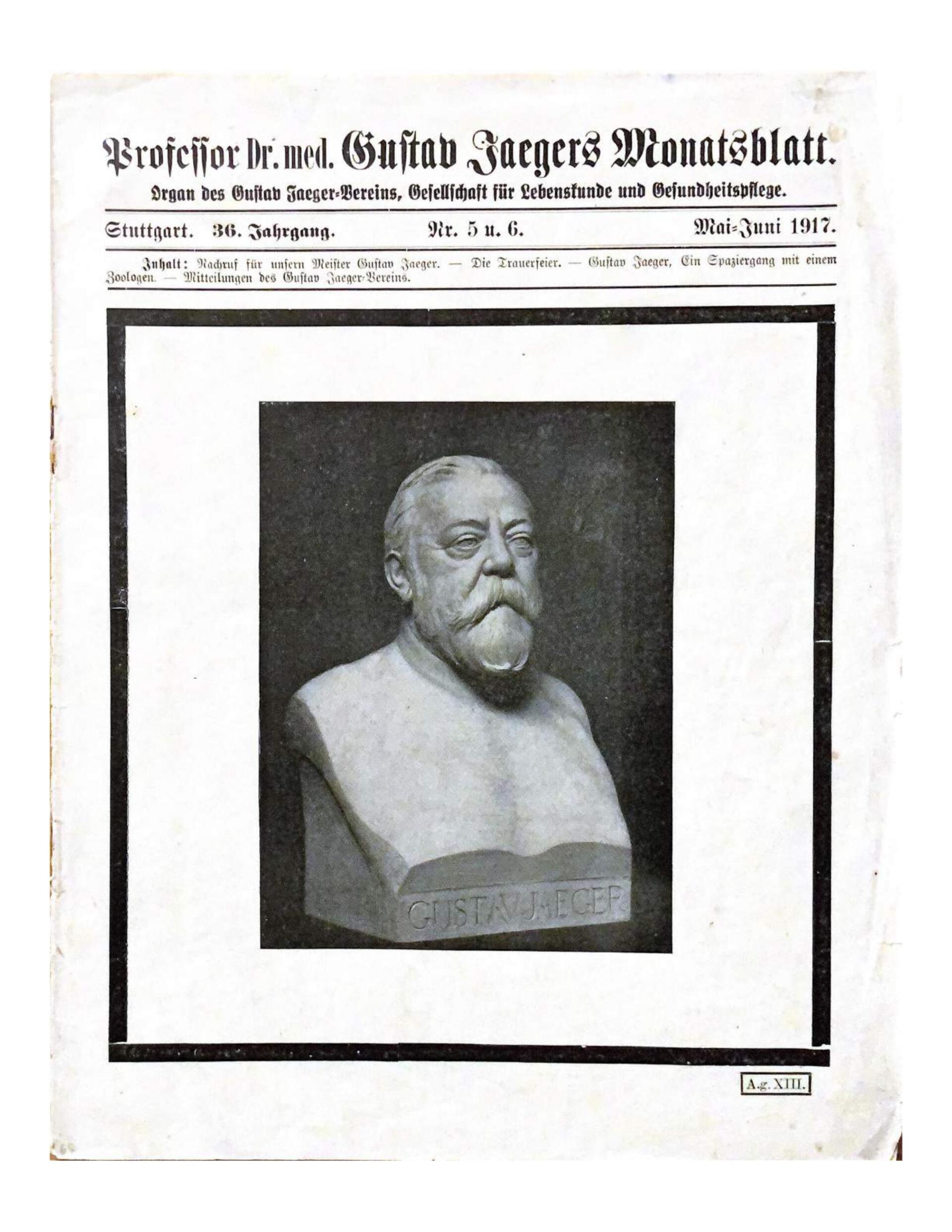Prof. Dr. med. Gustav Jaeger - 1832 - 1917 - born in Bürg am Kocher, died in Stuttgart
He was highly praised by everyone who could understand Jaeger, but by everyone who didn't have the horizon to follow him, he was put down and labeled a joke. Nothing has changed to this day, which has tried Jaeger. It's very easy to get lost in the great jungle of Jaeger's literature. He has written 220 scientific papers, very broad in scope. Whether people, animals, microbes, weather, clothing, raising children, language research... There is hardly a topic that Jaeger hasn't written something about. He vehemently defended what he once recognized as correct, such as: B. homeopathy. His opponents bit their teeth at him because he was extremely combative and didn't avoid anyone. He had a great sense of humor, was very hospitable, and always had an open ear and an open front door. The children from Murrhardt were given money if they said “Hello, Professor.” In the park of his summer house in Murrhardt he had all kinds of animals, e.g. B. tame wolves and a white deer, there was a swimming pond and a horse-drawn carriage and horses. He and my great-great-grandmother Selma had 9 children, 3 of whom died as children. - The family grave in Stuttgart at the Prague Cemetery is a listed building. - Shortly before his death on May 13, 1917, he dictated his biography to his second wife Helene, which unfortunately remained unfinished. I published these in my book "The Legacy of the 7th Perfume - Love". This version cannot be found in any other book. That's why this book is a treasure. He was a warrior as a child and teenager and his mother always feared that one day he would certainly be brought home dead. His later room, with his brother in Stuttgart, was converted into an aviary... You get to know Affenwerner and hear stories, stories from all stages of life. He had to e.g. For example, when he moved out of his student apartment as a student and lived in a vineyard cottage just outside Tübingen, because he was passionate about examining animal, especially bird, skeletons and macerating them himself, the noses of his roommates were understandably very offended. ....- I would never have thought it possible that I would ever put my foot in someone's door, but I was taught otherwise that sometimes you don't know yourself anymore when I met Patrick Süskind in front of his house in Munich of the city, we greeted each other with a handshake, he wanted to run away when I said my name... You'll read it. So it's quite turbulent and there's no shortage of humor. So be sure to download the book “The Legacy of the 7th Perfume – Love”. You find it HERE in the webshop!
NON SCHOLA, SED NATURA ARTIS MAGISTRA
Not the school, but nature is our teacher.
Gustav Jaeger was not a normal doctor, as one would imagine. Rather, he was constantly researching nature. He didn't want to have to heal sick people, he wanted people not to get sick and looked for the reasons why people were sick. I see a great need for action here, because even today most people don't pay attention to what needs to be done BEFORE you get sick. That was Jaeger's strength: seeing people in their integration into nature, yes, as part of nature. In all of his books he therefore gives very deep insights into a way of thinking that the cult Roman people have lost. - It is therefore very important to me personally, Gustav Jaeger, to bring him into today's times, when everything old is collapsing and needs to be reorganized. A long overdue step towards nature. I wish that I can do my part to steer humanity towards its true NATURE.
Prof. Dr. med. Gustav Jaeger
CV
Below you will find the CV, which was written by Jaeger himself.
I took this from the pamphlets published in 1887. You can find the biography that Gustav Jaeger dictated to his second wife Helene shortly before his death, and which I illustrated, in my book "The Legacy of the 7th Perfume - Love".
At the bottom you will find a few buttons with the following items:
- Bibliography by Gustav Jaeger. More than 200 scientific papers, listed by name. My thanks go to Prof. Dr. Heinrich Weinreich!
- "A Swabian in Vienna", part 1 and part 2. - My thanks go to Prof. Anton Szanja!
- An article that appeared in Spektrum der Wissenschaft. My thanks go to Prof. Wolfgang Achtner!
- An article by Gustav Jaeger _ Detailed explanation of anthropins. By Gustav Jaeger.
Extra supplement to Prof. Dr. G. Jaeger's monthly paper No. 8, 1884
My CV
In response to various requests from Wollener and newspaper editors, I will now provide a brief description of my life and my work to date. Not only did I add these to the monthly paper, but I also had a large number of other prints made, which I make available to readers free of charge in order to be able to counteract the malicious statements made by my opponents about me. To make this easier for those who want to reprint in whole or in part, I speak of myself in the third person.
Dr. Gustav Jaeger was born in Bürg in Württemberg on June 23, 1832 as the son of a Protestant clergyman who also made a name for himself as a historian and whose family included doctors, scholars and clergy. He went through Latin school and the lower Protestant seminary because he was destined for a spiritual career. After completing his seminar career, he changed his career choice, initially studying modern languages and higher mathematics for a year as an intern at the Stuttgart Polytechnic, and working as a trainee at the Stuttgart Zoological Museum.
In 1851 he moved to the University of Tübingen and completed his studies in medicine and surgery, where he also earned a doctorate in his field. Since his goal was academic teaching, namely in the subjects of zoology and comparative anatomy, he went to Vienna in 1856, initially published several special papers in the reports of the Vienna Academy, then qualified as a private lecturer and at the same time was a tutor in the house of a manufacturer of chemical products .
Since he did not want to change his religion, he was prevented from accepting the chair of zoology and comparative anatomy at the University of Vienna that had been offered to him by the philosophy faculty, and so he turned to scientific practice, first in conjunction with a capitalist Seawater aquarium, later created a zoo as technical director of a stock company. When this venture collapsed, largely as a result of the political turmoil of 1864-66, he returned to his hometown of Stuttgart in the spring of 1866, where he spent a year writing popular scientific works and scientific feature articles, as well as scientific papers dealt with. In 1867 he first received a teaching position as an assistant teacher, first for zoology at the Agricultural and Forestry Academy in Hohenheim, which was later followed by a similar one at the Royal University. Stuttgart Polytechnic followed. These teaching assignments were later expanded in Hohenheim to include the microscopic internship, lectures on silk production and the management of the technical operations of silk farming, and at the Polytechnic with a teaching assignment for anthropology including health care, and he was appointed main teacher at the latter school.
For this purpose, in 1876 he was given an assistant teaching position at the Royal University. Veterinary school in Stuttgart for physiology, histology and microscopic internship.
As a result of the increased demands on the training of veterinarians, the main apprenticeship positions at the veterinary school had to be increased, and since Jäger was already busy with private work for his wool regime, he left the association of the veterinary school in 1881 and only had the training and examination of veterinary students in zoology, at the same time as the students of the polytechnic. He resigned from his main teaching position at the last school and the Hohenheim Academy in the spring of 1884 and retired to work as a licensed doctor.
From the above it can be seen that Jaeger has the most diverse knowledge and experience not only as a teacher and scholar, but also as a practitioner, especially in the field of animal husbandry, animal breeding (his name is also known among fish breeders), and as he too An insect collector, hunter and angler, he had to acquire something in the field of free, natural life. Evidence of this is Jaeger's extensive journalistic activity in these areas, about which the following can be briefly reported.
Even as a student he wrote an anatomical treatise in Müller's archive, which was later followed by several treatises published in the proceedings of the Vienna Academy of Sciences, and he also began his journalistic work in the popular scientific field as a student by writing animal descriptions in the illustrated magazine “The Book of the World”.
Jaeger's first scientific work, which made his name known in the scientific world in connection with the names of Cuvier and Bronn, was his treatise on symmetry and regularity (session report of the Vienna Academy).
When Darwin's work alarmed the scientific world in 1859, Jaeger was one of the first to side with the world-contested scholar, first through public lectures on Darwin's teachings, then through a series of smaller scientific treatises that were recognized form valuable additions to Darwin's teachings, and among which two treatises “On the longitudinal growth of bones” and “On the growth conditions” should be mentioned. Three larger independent writings followed later in the same direction:
- Zoological letters, Vienna, Braunmüller
- In the matter of Darwin versus Wigand, Schweizerbarth, Stuttgart
- Darwin's theory and its relationship to morality and religion, Thienemann Verlag, Stuttgart 1868.
His work in the pursuit of Darwin's teachings also includes the fact that Jaeger was one of the co-founders and, a few years later, one of the co-editors of the magazine "Kosmos", which was dedicated to Darwin's teachings.
In the field of popular scientific writing, Jaeger delivers numerous treatises, mostly containing new points of view, partly in daily newspapers, partly in weekly and monthly specialist publications, especially in the journal “Ausland” and in the already mentioned journal “Kosmos”. some of which were collected and augmented with new things and appeared as an illustrated work under the title “Skizzes from the Tiergarten”, Hamburg 1866. A counterpart to this is his illustrated work “Life in Water”, Hamburg 1866 and the aquarium. His microscopic studies led to the equally illustrated work “The Wonders of the Invisible World”, Berlin 1866. The study of free-living nature and Jäger's collecting activity provided the original work “Germany's Animal World”, Stuttgart, Gebr. Kröner, which also provided a practical guide to collecting . Also illustrated. Added here is an illustrated counterpart to the sketches from the zoo under the title “Wanderungen durch das Tierreich”, Stuttgart, Gebr. Kröner, and that Jaeger has published a new edition of the popular Rebau natural history and the beetle book by Calwer (Thienemanns Verlag). worried.
It should not go unmentioned that, in addition to this scientific and literary activity, he was also creatively active in other areas within the limits of his own subject. So are his essays “on the origin of human language”, his essays in the field of animal geography, which led him to the geological theory of the polar volatility of the land, and to the invention of a new cartographic projection method, the so-called “North Polar Star Projection” (Alles im Journal “Ausland” appeared), works that will certainly win a place in the history of these sciences.
Jaeger's work in the field of hygiene began again, on the one hand, with smaller scientific treatises in specialist journals and, on the other hand, with popular publications in daily and weekly newspapers. Jaeger's first, sensational book in this direction was the work "Human Work Power", Munich, Oldenburg 1878, about which a specialist journal, the Vienna Medical Press, Year 1878 No. 35, writes the following:
“But what gives the work a very special value are the hygienic principles, which the author derives from the latest research results both astutely and casually. Here we are dealing with a popular presentation that has not been copied, and in which an original thinker and observer has put down more noteworthy things than one could otherwise hope to find in 10 years of learned academic writings...”
His work “Epidemic Resistance and Constitutional Power” appeared almost at the same time, Leipzig, E. Günthers Verlag 1878.
This was followed in 1880 by the first pamphlet that served Jaeger's practical hygienic goals, “Normal clothing as health protection” (published by W. Kohlhammer in Stuttgart), a collection of his small essays in the “Neues deutsche Familienblatt”, which to this day has had three editions, each of which has been greatly increased, and one English and a Swedish translation. In the same year, Jaeger's main work was published under the title "The Discovery of the Soul", first as a small brochure that was quickly sold out and then expanded into a book as a second edition, Leipzig, Ernst Günthers Verlag 1880. The same is currently being published in a significant way (in two volumes ) increased, delivered in 2 volumes in a third edition.
Jäger's teaching activities resulted in his “Textbook of General Zoology”, Ernst Günthers Verlag, I. Vol. 1871, II. Vol. 1878.
Finally, it should be mentioned that G. Jaeger is a collaborator and initially editor of the Concise Dictionary of Zoology, Anthropology and Ethnology, which is a part of the Encyclopedia of Natural Sciences, Eduard Trewendt, Breslau 1880.
Since November 1881, Jaeger has had his own monthly newspaper dedicated to the further development of his teaching and practice under the title “Professor Dr. G. Jaeger’s monthly paper” out.
In recognition of his achievements as a scholar, Jaeger holds diplomas as an honorary member, actual or corresponding member of 10 scientific societies or associations at home and abroad.
Gustav Jaeger's great-great-grandparents were Carl Friedrich Jäger (1690 - 1727) and Regina Catharina Martini (1696 - ?) - Carl Friedrich died of a stroke at the age of 37. Regina Catharina, my 6-times great-grandmother, married a second time: Christof Ludwig Süskind (pastor in Hausen near Brackenheim, Waldenbuch, Stetten im Remstal), Patrick Süskind's 5-times great-grandfather. - This is where the threads of our ancestors come together. See photo on the right, from the Jaeger family chronicle of Hans Jaeger, Erlangen, my mother's great cousin.







